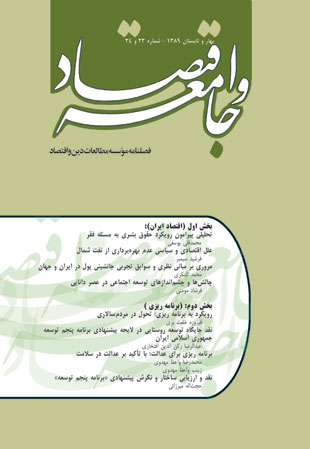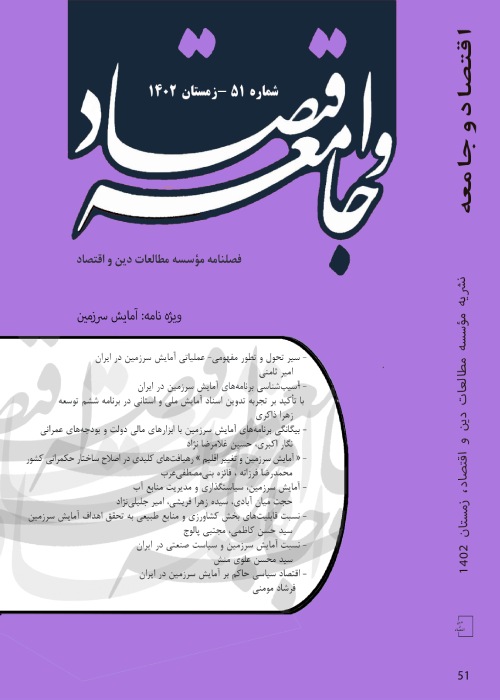فهرست مطالب

نشریه اقتصاد و جامعه
پیاپی 23-24 (بهار و تابستان 1389)
- 240 صفحه، بهای روی جلد: 20,000ريال
- تاریخ انتشار: 1389/06/01
- تعداد عناوین: 8
- بخش اول: اقتصاد ایران
- بخش دوم: برنامه ریزی
-
Page 11Human rights are inalienable entitlements, reflecting the crucial interdependence of economic, social and cultural rights on the one hand, and civil and political rights on the other. Individuals as the units of action, as the entities who think feel, choose and act,are entitled to live as they choose, free from interference by other persons or by the state.However, Poverty deprive them of using such privileges. Poor people are afflicted with hunger, malnutrition, ill-health, unsanitary housing, poor living conditions and various other deprivations. They do not have the resources to overcome these afflictions and withpassage of time, their problems aggravates and become complicated. Poverty is key barrier of development.It holds back development. In short poor people lack freedom to lead a life with dignity. Poverty is basically a violation of natural rights of man. And block its mobility. Therefore, serious step is to be taken to eliminate poverty. No longer we can regard poverty as a technical problem and expect to be eliminated automatically through economic growth. The time has come to regard it as a violation of human rights and take it as an obligation and responsibility of states to fight it seriously and do not regard it as a charity measure. It is true that we can not blame any special body as a violator of widespread poverty and draw a bright poverty line, nevertheless, recognition of it as a human right violation is a very important step towards its elimination. The removal of poverty, therefore become a moral and political obligation of all the states, national authorities and International organizations to take serious step for its elimination.
-
Page 43Northern oil fields of Iran has been one of the most complicated historical problems of the country, having wider implication for its international political relations. Despite, having over hundred years of oil explorations, in the country, the ambiguity surrounding northern oil fields regarding its operation, extent of oil reserves, the exact location of oil reserves and oil wells, the cost of operation and transportation, etc, still remained unresolved. Following a historical and analytical approach in this paper, we try to provide enough evidence to show that historically five factors have been responsible for the inactiveness of northern oil fields.
-
Page 83Using the currency substitution theory, this paper attempts identify the determinants of currency substitution degree. This paper has’nt hypotheses. This paper helps to experience researchs in Iran and The other Countries that have problem of currency substitution.
-
Page 117During the last six decades, the problem of selecting the most suitable starting point for development has been utmost challenging aspects of theoretical discussion regarding the choice of policy and priority in practice towards development. In this paper we try to show historically that while the starting point of changes in Europe has been the weight given to the changes in perspicacity and insight and social development leading to industrial revolution, on the contrary, this vital aspect of development has been neglected in developing countries. Inadequate attention paid to social development in developing countries, particularly during 1950-1990 period, has been the main factor for the persistence of underdevelopment in large part of the developing world. Taking into consideration the process of globalization, it seems imperative on the part of developing world to give more emphasize on social development and pay more attention to social aspect o development.
-
Page 147The core of the research is the claim that there are different approaches to planning, but all countries should have a sort of planning for their long-term outlook. The paper discusses the specifications to distinguish types of plans. It is shown that with the democratic movement in different societies, the approach to planning has also moved towards more democratic shapes, and in particular towards community-based planning.The paper discusses various parameters distinguishing different types of planning and leads to the conclusion that there are common points in all types of plans. The discussion is extended to the actions needed for successful management and monitoring of the plans and the current world experience of various countries in choice of planning and monitoring their plans.
-
Page 169The critic is one of the judgment instrument and measure plan and its one of the acceptable method on scientific society. This method is evolving and opening up the strength and weaknesses of planning process for suitable decision making and providing best option and possibility scenario’s for territorial management. This method with critical thinks is the public dialog for policy and planning. with this framework the strategic question is “what are the characters of the fifth plan of IRI on the dimension of thought, method and action and what the place of the rural development is in this plan?
-
Page 191Holy Qoran has categorically stated that the main prophetic mission is to bring justice. Justice is the missing objects in historical search of human beings. There has been various social movements aiming to bring about justice.At the same time despite significant economic progress the aim of achieving justice has remained unfulfilled. Economic progress has been accompanied by growing inequalities. Unequal social competition and dominance of the rich over the poor in terms ofpower, wealth and knowledge perpetuated inequalities and class conflicts. Social Justice can not be achieved by leaving the things to spontaneous market forces. It needs conscious planning. The main aim of planning is to help downtrodden and those excluded from economic activities. A very important aspect of social justice is justice in health services. Various studies within the country and abroad have shown that if the health management is left to spontaneous market forces, and the allocation of health resources and services are not properly decided, the market forces has the tendency to by pass the very needed persons in the society. Since health care is a must and is not something optional, lack of access to health services would lead to premature death, infirmities and disabilities of various kinds, creating a circle of poverty, illness and disabilities. Therefore, to break such vicious circle of health poverty, proper planning is needed to reduce inequalities and facilitate the access to health care. Thus to achieve justice and reducing inequalities, provision of health care and its accessibility by lower section of society is inevitable.
-
Page 211Development Plan generally reflects simultaneously the twin quality of Purposefulness and Rationality in any socio economic order. Purposefulness imply general agreement of political system and rationality element is indicative of the society professionalconsensus. Thus a plan is the product of these two elements. Desirable functioning of planning system, however, depends upon recognition of five basic principles. These include: forward orientation, systemic approach, participation, coordination andcontinuity.At the same time every development plan is based on insights, sound theoretical foundation and a series of professional survey and research reaching conclusion about development, its meaning and content, having a good appraisal of world order and place and position of the country in this order, taking into account the country economic structure, its institutions and its historical processes. In this Paper, we try to evaluate the aim, objectives, content and the perspectives of the fifth development plan. A glimpse at content of the proposed plan would clearly show that it is weak, imprecise and lack consistency and continuity. We try in this paper to critically evaluate its structure, content and its theoretical and practical foundations.


